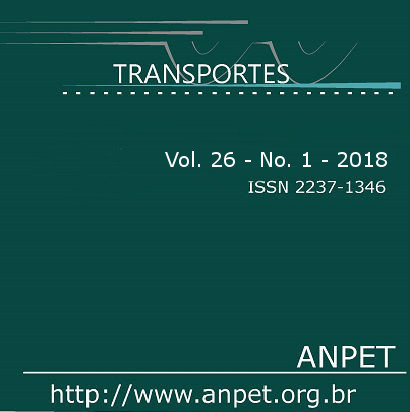Correlação da energia de fratura com parâmetros reológicos de ligantes e mástiques asfálticos
DOI:
https://doi.org/10.14295/transportes.v26i1.1150Keywords:
Mineral filler, Asphaltic mastic, Rheological properties, Fracture energy.Abstract
The fracture energy is a property related to the contribution of asphalt binders to the fatigue resistance of asphalt mixtures and therefore has great influence on the mechanical behavior of flexible pavements, particularly in the development and propagation of cracks. This research aims to contribute to a better understanding of the effects of mineral fillers on the fatigue cracking of asphalt mixtures, at intermediate temperatures, through the Binder Fracture Energy (BFE) test, developed at the University of Florida, with determination of the fracture energy as a function of the type and content of mineral fillers and asphalt binder. The results show that the fracture energy can be related to the dynamic shear modulus (G *) and phase angle (δ), obtained from tests in the dynamic shear rheometer (DSR), and with the stiffness [S (t)] and the relaxation modulus [m (t)], obtained from tests in the bending beam rheometer (BBR).
Downloads
References
Anderson, D.A. e R. Dongre (1995) The SHRP Direct Tension Specification Test – Its Development and Use. Physical Properties of Asphalt Cement Binders, J.C. Hardin, Ed. ASTM Special Technical Publication 1241.
American Society for Testing and Ma-terials, Philadelphia, PA, p. 51-66.
Anderson, D. A.; L. Lapalu; M.O. Marasteanu; Y. M. L. Hir; J. P. Planche e D. Martin (2001) Low-temperature thermal cracking of asphalt binders as ranked by strength and fracture properties, Journal of the Transportation Research Board, v. 1766, p.1-6.
Bahia, H.; H. Wen e C.M. Johnson (2010) Developments in intermediate temperature binder specifications. Transportation Research Circular, E-C147, December, p.25-33.
Hoare, T. R. e S.A. Hesp (2000) Low-temperature fracture testing of asphalt binders, Journal of the Transportation Research Board, v. 1728, p.36-42.
Huang, S. C.; J. C. Petersen; R. E. Robertson e J. F. Branthaver (2001) Effect of Hydrated Lime on the Long-Term Oxidative Aging Characteristics of Asphalt. Transportation Research Record
Huang, S.C.; J. C. Petersen; R. E. Robertson e J. F. Branthaver (2002) Effect of hydrated lime on long-term oxidative aging characteristics of asphalt. Transportation Research Record, n. 1810, p. 17-24.
Huang, S. C e M. ZENG (2007) Characterization of aging effect on rheological properties of asphalt-filler systems. International Journal of Pavement Engineering, v. 8, n. 3, p. 213–223
Ishai, I. e J. Craus (1977) Effects of the Filler on Aggregate-Bitumen Adhesion Properties in Bituminous Mixtures. Proceedings of the Association of Asphalt Paving Technologists, v. 46, p. 228-258.
Kim, Y.R.; D.N. LITTLE e I. Song (2003) Effect of mineral fillers on fatigue resistance and fundamental material characteristics – mechanic evaluation. Transportation Research Record, no.1832, Transportation Research Board of the National Acade-mies Washington, D.C., p. 1-8.
Koh, C. e R. Roque (2010) Use of Nonuniform Stress-State Tests to Determine Fracture Energy of Asphalt Mixtures Accura-tely. Transportation Research Record: Journal of the Transportation Research Board, No. 2181, Transportation Research Bo-ard of the National Academies, Washington, D.C., p. 55–66.
Pinilla, A. (1965) O sistema fíler-betume, algumas considerações sobre sua importância nas misturas densas. Conselho Nacional de Pesquisa. Instituto de Pesquisas Rodoviárias.
Ponniah, J.E.; R.A. Cullen e S. A. Hesp (1996) Fracture energy specifications for modified asphalts. Preprints of Papers, Jour-nal Volume 41, Journal Issue 4, Conference 212, National meeting of the American Chemical Society (ACS), Orlando, FL, USA, p. 25-30 August 1996.
Romeo, E. (2008) Measurement and Prediction of Fundamental Tensile Failure Limits Of Hot Mix Asphalt (HMA). Doctoral disser-tation. University of Florida, Gainesville, FL.
Roque, R.; G. Lopp; W. Li e T. Niu (2009) Evaluation of Hybrid Binder Use In Surface Mixtures In Florida. Final report for FDOT BD-545 Contract, University of Florida, Gainesville, FL.
Roque, R.; T. Niu e G. Loop (2012) Development of a Binder Fracture Test to Determine Fracture Energy. Final report for FDOT BDK-75-977-27 Contract, University of Florida, Gainesville, FL.
Walker, Dwight (2017) Refining Superpave asphalt binder characterization. Asphalt: The Magazine of the Asphalt Institute. Nota técnica. Disponível em: http://asphaltmagazine.com/refining-superpave-asphalt-binder-characterization/. (Aces-sado em 01 de junho de 2017)
Downloads
Published
How to Cite
Issue
Section
License
Copyright (c) 2018 Vivian Silveira dos Santos Bardini, Luis Miguel Gutiérrez Klinsky, José Leomar Fernandes Júnior, Reynaldo Roque

This work is licensed under a Creative Commons Attribution 4.0 International License.
Authors who submit papers for publication by TRANSPORTES agree to the following terms:
- The authors retain the copyright and grant Transportes the right of first publication of the manuscript, without any financial charge, and waive any other remuneration for its publication by ANPET.
- Upon publication by Transportes, the manuscript is automatically licensed under the Creative Commons License CC BY 4.0 license. This license permits the work to be shared with proper attribution to the authors and its original publication in this journal.
- Authors are authorized to enter into additional separate contracts for the non-exclusive distribution of the version of the manuscript published in this journal (e.g., publishing in an institutional repository or as a book chapter), with recognition of the initial publication in this journal, provided that such a contract does not imply an endorsement of the content of the manuscript or the new medium by ANPET.
- Authors are permitted and encouraged to publish and distribute their work online (e.g., in institutional repositories or on their personal websites) after the editorial process is complete. As Transportes provides open access to all published issues, authors are encouraged to use links to the DOI of their article in these cases.
- Authors guarantee that they have obtained the necessary authorization from their employers for the transfer of rights under this agreement, if these employers hold any copyright over the manuscript. Additionally, authors assume all responsibility for any copyright infringements by these employers, releasing ANPET and Transportes from any responsibility in this regard.
- Authors assume full responsibility for the content of the manuscript, including the necessary and appropriate authorizations for the disclosure of collected data and obtained results, releasing ANPET and Transportes from any responsibility in this regard.









